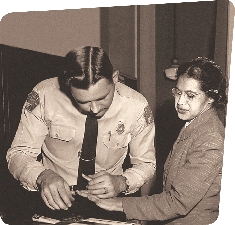Changing the System
Rosa Parks
Montgomery, Alabama, was a segregated city in 1955. African Americans were treated as second class citizens there. The public bus system was a constant reminder of this.
As in many Southern cities, more blacks rode the city buses than whites. Even so, the first ten rows of every bus were reserved for white passengers only. If a bus was crowded and a white passenger needed a seat, blacks had to stand. Black passengers had to pay their fares at the front of the bus, but then they had to get off the bus and re-board by the back door. At busy times, the bus sometimes left before everyone who had paid got back on.
On December 1, 1955, Rosa Parks was riding the bus home from work. She was a seamstress, and she also worked at the local NAACP office. Parks had been on her feet all day, and she was tired. She was sitting in the eleventh row—the first row of seats set aside for African American passengers.
The bus was crowded and some black passengers were standing at the back. When a white man needed a seat, the bus driver ordered Parks and three African Americans in her row to stand. She refused to move and Parks was taken off the bus, arrested, and put in a jail cell.
News of Parks’s arrest shocked the African American community. Civil rights supporters saw that this was their chance to change the rules. They asked Martin Luther King, Jr., to be their leader. That evening, Dr. King spoke to a cheering crowd of African Americans and he called for them to start a bus boycott, which meant they would not ride the buses.

Rosa Parks is fingerprinted at the police station.